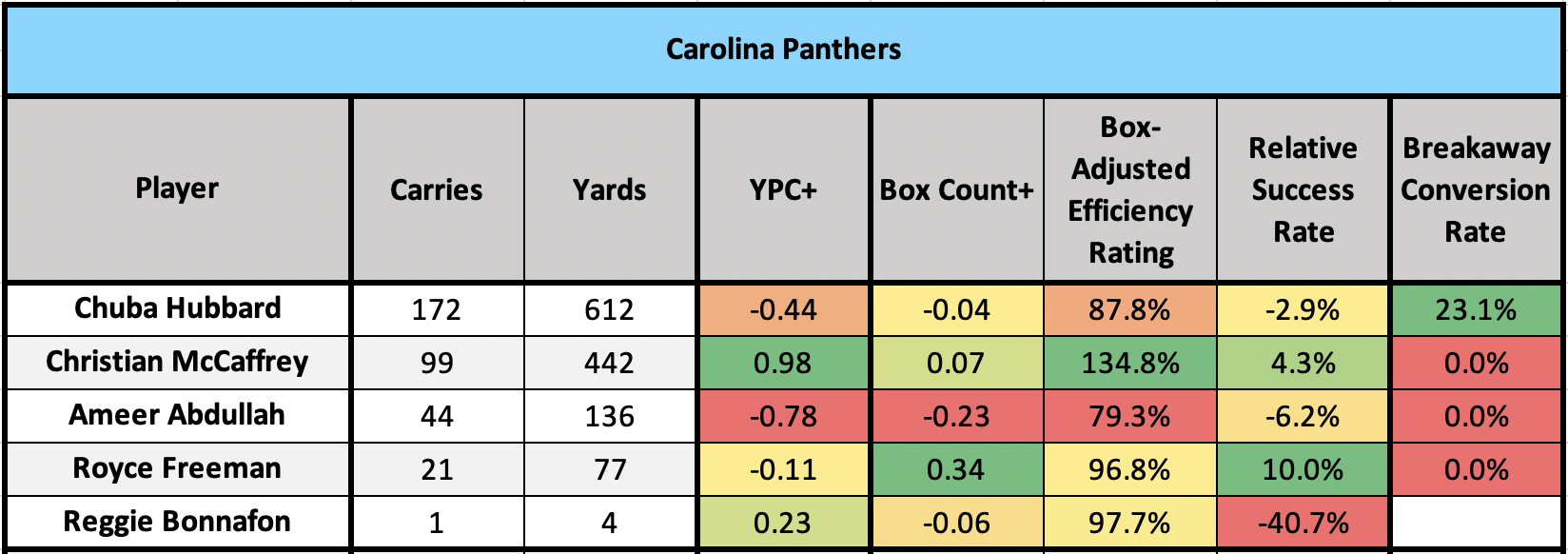The 2022 Panthers Backfield Breakdown is part of an offseason series in which I take a deep dive into one NFL team’s backfield and examine the respective rushing performances of the players in it. In doing so, I hope to gain insights into key players from a talent evaluation standpoint and use that evaluation as a baseline from a dynasty valuation standpoint. The first installments in the series can be found here.
I’ll start by taking a quick overview of each team’s raw rushing volume and propensity to run the ball. Then, I’ll dive into the player evaluation portion. Before we start, let’s define the metrics I’ll use as part of those evaluations:
Key Metrics
Yards per Carry+ (or YPC+)
The degree to which a player’s raw yard per carry average exceeds or falls short of the collective yard per carry average of all other running backs on his team. Meant to be an overview of a player’s team-relative efficiency.
Box Count+
The degree to which the average amount of defenders in the box that a player faces on his runs exceeds or falls short of the collective average faced by the other running backs on his team. Considering that the outcome of any given rushing attempt is largely dependent on the number of defenders in the box pre-snap, Box Count+ describes the relative degree of difficulty of a running back’s carries.
Breakaway Conversion Rate (BCR)
Quantifies performance in the open field by measuring how often a player turns his chunk runs of at least 10 yards into breakaway gains of at least 20 yards.
Box-Adjusted Efficiency Rating (BAE Rating)
Improves upon YPC+ by accounting for the box counts that a player carried the ball against. Looks at team-relative yards per carry against each individual box count, then uses a weighted average (based on total carries against each box count) to generate an overall score. A score of 100-percent indicates that a player is producing exactly the per carry output of his teammates, a score above 100-percent indicates that he is outdoing their per carry output to whatever degree, and vice versa for a score below 100-percent.
Relative Success Rate (RSR)
Measures player consistency using Success Rate, but relative to his teammates and adjusted for the box counts that he faced in the same way that BAE Rating is. “Success” on a given carry is defined by gaining 40-percent of yards needed on first down, 70-percent of yards needed on second down, and 100-percent of yards needed on third or fourth down. A score of 0.0-percent indicates that a player is succeeding on exactly the same percentage of his carries as are the other backs on his team, a positive score indicates that he is succeeding more often than his teammates are, and vice versa for a negative score.
Volatility Rating
Measures the disparity between a running back’s percentile ranks in BAE Rating and RSR in order to indicate how volatile a player’s per-carry performance is. High overall efficiency paired with low rate of success indicates boom/bust output, while low overall efficiency paired with high rate of success indicates steady, low-ceiling output. Measures degree of volatility, not quality of performance.
Composite Efficiency Score (CES)
Presents a single-metric overview of the quality of team-relative performance a player produced on his carries in a single season. Calculated using the average of a player’s percentile ranks in Box-Adjusted Efficiency Rating and Relative Success Rate, represents player performance on a 0-100 scale.
Check out Christian McCaffrey‘s 2022 Projection on PlayerProfiler’s “World Famous” Draft Kit:
Team Rushing Volume
The Carolina Panthers finished No. 15 in the NFL in total rushing attempts last season. Their 455 totes were just two more than league average. In the 2020 season, the first year of the Matt Rhule era, they were No. 21 in the same category. The 2019 season, before Rhule took over, was the last time they had Christian McCaffrey healthy for an entire season. Carolina finished No. 24 in rushing attempts in 2019.
According to rbsdm.com, the Panthers’ propensity to call run plays in early-down situations with a neutral game script (when win probability for either team did not exceed 80-percent) was right in line with their raw volume, as they also finished No. 15 in this category a year ago. The year prior, they finished No. 11.
Situationally, the Panthers were slightly run-heavy compared to expectations based on league-wide play-by-play data. Given the down-and-distance situations they found themselves in, they opted to run the ball one-percent more often than expected.
Changes are perhaps in store for the running game in Carolina for 2022. Joe Brady is out as offensive coordinator, and he’s been replaced by former New York Giants head coach Ben McAdoo. While with the Giants between 2014 and 2017, McAdoo’s offenses were not especially run-heavy. They finished No. 10, No. 19, No. 23, and No. 25, respectively, in total carry volume in each season. In early-down and neutral script situations during that time, they were No. 21 in run volume.
With McAdoo in charge (and McCaffrey hopefully available throughout the year), we could see a slight dip in rushing volume in Carolina.
Efficiency Numbers
McCaffrey was the main man in this backfield in between missing long stretches of the 2021 season. However, his absence left enough time for Chuba Hubbard to finish with the team-lead in carries. Behind them, a pair of formerly highly-touted prospects in Ameer Abdullah and Royce Freeman saw light work. Reggie Bonnafon had a solitary rushing attempt. Here are the full rushing efficiency profiles for each of those five backs:
After posting an 88.1-percent Box-Adjusted Efficiency Rating at Oklahoma State in 2020 that landed in the 32nd-percentile for college backs, Hubbard was equally bad as a pro in 2021. In the NFL, his 87.8-percent BAE Rating comes in at the 29th-percentile. Hubbard’s failed to consistently churn out positive yardage even outside the context of overall efficiency. His Composite Efficiency Score of 33.4 ranked as the No. 3 lowest among backs who led their teams in carries last season.
The Rest of the Backups
We’ll touch on the ancillary backs before getting to McCaffrey. Abdullah provided less efficient and consistent touches than the collective other backs while seeing significantly lighter box counts than those they saw.
Freeman, on the other hand, saw heavy boxes and came close to breaking even against them. His Box Count+ mark is in the 90th-percentile. While Freeman was barely less efficient than his teammates given those heavy fronts, he was able to create positive outcomes on a large percentage of his carries. This is evidenced by a Relative Success Rate that also lands in the 90th-percentile.
Bonnafon is hardly worth mentioning here, but he gained four unsuccessful yards on one carry against a 7-man box.
McCaffrey
McCaffrey proved fantastic on a per-carry basis last season. Among backs with between 50 and 100 carries, his CES ranked behind only Deebo Samuel, Duke Johnson, and Dontrell Hilliard a year ago. If we cheat a little bit and include McCaffrey among players with at least 100 carries, he ranks behind only Najee Harris, Jonathan Taylor, James Robinson, and Rex Burkhead.
So Now What?
2021 marked the first season since 2018 in which McCaffrey posted a BAE Rating above the 100-percent mark. However, he has had positive RSR numbers in every season of his career. He also was producing at an elite per-game level in fantasy even while underperforming the efficiency of his teammates in 2019 and 2020. There’s a chance that the recent injuries have piled up to such a degree that he doesn’t have it anymore. It also seems plausible McCaffrey still has enough juice to contribute at a high level in 2022.
From a valuation standpoint, I think he’s a bit overrated in dynasty. According to DLF, McCaffrey is currently being drafted as the RB3 and as the No. 7 player overall in single-QB startups. For a 26-year old back who’s played less than a third of his games in the last two years, the middle of the first round seems egregiously high in a long-term format. In redraft, you have to shoot your shot, but I have McCaffrey at RB9 in dynasty.
The Best of the Rest
The rest of this running back depth chart has been almost completely remade since last season. Along with McCaffrey and Hubbard, the other backs currently under contract are D’Onta Foreman and a trio of undrafted free agents in John Lovett (signed this offseason), Darius Bradwell (in the league since 2020), and Spencer Brown (signed in 2021).
None of these other guys are very exciting, but for my money, Foreman is the No. 2-best back on this team. Foreman proved himself a dynamic runner as a Texas Longhorn and as a Houston Texan prior to tearing his Achilles back in 2017. He also provided a near 1-to-1 copy of Derrick Henry‘s efficiency during his stretch as the Titans lead runner last season. Currently being drafted as the RB65, it wouldn’t shock me to see him beat out Hubbard. He will also be in line for solid work in the event of a McCaffrey injury.
Hubbard himself is being drafted as the RB62. I don’t think he’s very good, but he’s cheap enough to warrant taking a flyer on even considering his poor play last season.
Final Word
I’m much more scared of McCaffrey than everyone else seems to be. He gave us some of the best individual seasons of all time. However, age and injury catch up to everyone at some point, and he’s had a hard go of it lately. Godspeed to those of you with the balls to appoint him as your most important player in dynasty.



